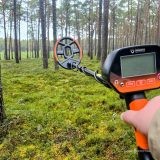Air Test Garrett ACE 300i on detection depth (+ Results)
Many consider the metal detector Garrett ACE 300i as the best option for both the beginning digger, as well as for already experienced diggers. This detector is slightly more expensive than ACE 250, but has a number of useful features and design solutions that makes the detecting more comfortable productively. ACE 300i has everything on why to buy it, and not the previous model.
But how will the detector react to different valuable items that digers are looking for? And what if the ACE 300i will react badly or not react at all on some coins?
Today we will try to answer these questions. Therfore we will preform an air-test to determine the maximum range at which the detector will pick up different targets. To this test we selected the most, in our opinion, interesting finds:

Denarius – these coins are almost 2000 years old
“Scale” – One of the smallest of the common silver coins
Solidus – a very popular medieval coin
Ekaterina II 5 kopeks – the biggest imperial copper coin
2 kopeks 1814 – the queen in the fields
A Uniform Button – common on soldiers of the russian imperial army
5 kopeks 1930 – similar to the rare 5 kopeks 1933
2 kopeks 1940 – similar to the rare kopeks 1927
Soviet vodka cork – the most common garbage
A golden wedding ring – the most desired find
Garrett Metal Detectors ACE Series is very easy to configure. The settings for this test was: zero-disc mode (all metals), maximum sensitivity, F4 frequency.

And so: after testing, here are the results:
| Test object | Depth detection in cm. |
| denarius | 20 |
| scale | 14 |
| solidus | 19 |
| Ekaterina 5 kopeks | 31 |
| 2 kopeks 1814 | 29 |
| The Uniform button | 28 |
| 5 kopeks 1930 | 31 |
| 2 kopeks 1940 | 26 |
| vodka cork | 31 |
| gold ring d = 29mm | 29 |
Overall, the result for the Garrett ACE 300i with the standard coil 7 × 10 inches are good: the maximum depth at the objects was good.








